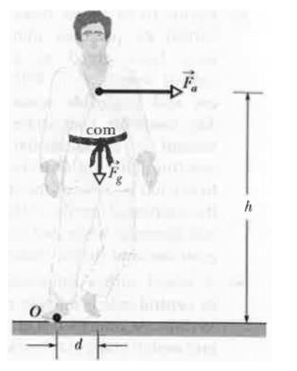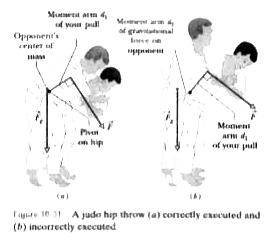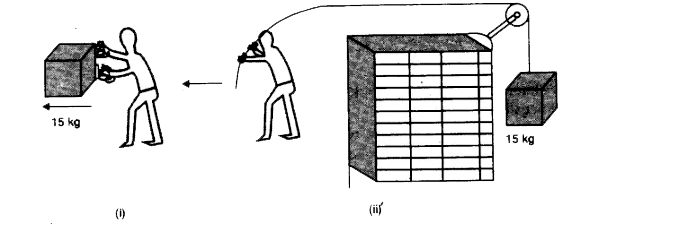Assertion: A judo fighter in order to throw his opponent onto the mattress, he initially bends his opponent and then rotates him around his hip.
Reason: As the mass of the opponent is brought closer to the fighter's hip, the force required to throw the opponent is reduced.
If both assertion and reason are true and the reason is the correct explanation of the assertion.
If both assertion and reason are true but reason is not the correct explanation of the assertion.
If assertion is true but reason is false.
If the assertion and reason both are false.
The correct Answer is:A
Through bending weight of opponent is made to pass through the hip of judo fighter to make its torque zero.
Topper's Solved these Questions
- ROTATIONAL MOTIONBOOK - ERRORLESSCHAPTER - ROTATIONAL MOTIONEXERCISE - NCERT BASED QUESTIONS (Torque and Couple)
27 Videos
- ROTATIONAL MOTIONBOOK - ERRORLESSCHAPTER - ROTATIONAL MOTIONEXERCISE - Assertion & Reason
25 Videos
- ROTATIONAL MOTIONBOOK - ERRORLESSCHAPTER - ROTATIONAL MOTIONEXERCISE - PAST YEARS QUESTIONS
70 Videos
- NEWTON'S LAWS OF MOTIONBOOK - ERRORLESSCHAPTER - NEWTON'S LAWS OF MOTIONEXERCISE - ASSERTION & REASON
18 Videos
- SIMPLE HARMONIC MOTIONBOOK - ERRORLESSCHAPTER - SIMPLE HARMONIC MOTIONEXERCISE - Assertion & Reason
15 Videos
Similar Questions
In a judo foot-sweep move, you sweep your opponent's left foot out from under him while pulling on his gi (uniform) toward that side. As a result, your opponent rotates around his right foot and onto the mat. Figure 10-67 shows a simplified diagram of your opponent as you face him, with his left foot swept out. The rotational axis is through point O. The gravitational force →Fg on him effectively acts at his center of mass, which is a horizontal distance d = 28 cm from point O. His mass is 75 kg, and his rotational inertia about point O is 65kgm2. What is the magnitude of his initial angular acceleration about point O if your pull →Fa on his gi is (a) negligible and (b) horizontal with a magnitude of 300 N and applied at height h = 1.4 m?

View SolutionTo throw an 80 kg opponent with a basic judo hip throw, you intend to pull his uniform with a force →F and a moment arm d1 = 0.30 m from a pivot point on your right hip. You wish to rotate him about the pivot point with an angular acceleration α of −6.0rad/s2 - that is, with an angular acceleration that is clockwise in the figure. Assume that his rotational inertia I relative to the pivot point is 15kg⋅m2.
(a) What must the magnitude of →F be if, before you throw him, you benf your opponent forward to bring his center of mass to your hip?
(b) What must the magnitude of →F be if your opponent remains upright before you throw him, so that →Fg has a moment arm d2=0.12m?

View Solution
Knowledge Check
A judo fighter in order to throw his opponent on the mat tries to initially bend his opponent and then rotate him around his hip.
As the mass of the opponent is brought closer to the fighter's hip, the force required to throw the opponent is reduced.AIf both assertion and reason are true and reason is the true explanation of assertion.BIf both assertion and reason are reason are true but reason is not the correct explanation of assertion.CIf assertion is true but reason is falseDIf both assertion and reason are false.Santiniketan embodies Rabindranath Tagore.s vision of a place of learning that is unfettered by religious and regional barriers. Established in 1863 with the aim of helping education go beyond the confines of the classroom, Santiniketan grew into the Visva Bharati University in 1921, attracting some of the most creative minds in the country.
He developed a curriculum that was a unique blend of art, human values and cultural interchange. Even today, in every step, in every brick and in every tree at Santiniketan, one can still feel his presence, his passion, his dedication and his pride in the institution.
In 1862, Maharishi Debendranath Tagore, father of Rabindranath, was taking a boat ride through Birbhum, the westernmost corner of Bengal, when he came across a landscape that struck him as the perfect place for meditation. He bought the large tract of land and built a small house and planted some saplings around it. Debendranath Tagore decided to call the place Santiniketan, or the .abode of peace., because of the serenity it brought to his soul. In 1863, he turned it into a spiritual centre where people from all religions, castes and creeds came and participated in meditation.
In the years that followed, Debendranath.s son Rabindranath went on to become one of the most formidable literary forces India has ever produced. He wrote in all literary genres but he was first and foremost a poet. As one of the earliest educators to think in terms of the global village, he envisioned an education that was deeply rooted in one.s immediate surroundings but connected to the cultures of the wider world.
Located in the heart of nature, the school aimed to combine education with a sense of obligation towards the larger civic community. Blending the best of western and traditional eastern systems of education, the curriculum revolved organically around nature with classes being held in the open air. Tagore wanted his students to feel free despite being in the formal learning environment of a school, because he himself had dropped out of school when he found himself unable to think and felt claustrophobic within the four walls of a classroom. Nature walks and excursions were a part of the curriculum, special attention was paid to natural phenomena and students were encouraged to follow the life cycles of insects, birds and plants.
The rural paradise of Santiniketan, Tagore.s erstwhile home, has become a thriving centre of art, education and internationalism over the years.
What did Santiniketan initially serve as?AA classroomBA spiritual centerCA holiday resortDA summer houseRead the given passage and answer the questions that follow.
Santiniketan embodies Rabindranath Tagore’s vision of a place of learning that is unfettered by religious and regional barriers. Established in 1863 with the aim of helping education go beyond the confines of the classroom, Santiniketan grew into the Visva Bharati University in 1921, attracting some of the most creative minds in the country. He developed a curriculum that was a unique blend of art, human values and cultural interchange. Even today, in every step, in every brick and in every tree at Santiniketan, one can still feel his presence, his passion, his dedication and his pride in the institution. In 1862, Maharishi Debendranath Tagore, father of Rabindranath, was taking a boat ride through Birbhum, the westernmost corner of Bengal, when he came across a landscape that struck him as the perfect place for meditation. He bought the large tract of land and built a small house and planted some saplings around it. Debendranath Tagore decided to call the place Santiniketan, or the ‘abode of peace’, because of the serenity it brought to his soul. In 1863, he turned it into a spiritual centre where people from all religions, castes and creeds came and participated in meditation.
In the years that followed, Debendranath’s son Rabindranath went on to become one of the most formidable literary forces India has ever produced. He wrote in all literary genres but he was first and foremost a poet. As one of the earliest educators to think in terms of the global village, he envisioned an education that was deeply rooted in one’s immediate surroundings but connected to the cultures of the wider world.
Located in the heart of nature, the school aimed to combine education with a sense of obligation towards the larger civic community. Blending the best of western and traditional eastern systems of education, the curriculum revolved organically around nature with classes being held in the open air. Tagore wanted his students to feel free despite being in the formal learning environment of a school, because he himself had dropped out of school when he found himself unable to think and felt claustrophobic within the four walls of a classroom. Nature walks and excursions were a part of the curriculum, special attention was paid to natural phenomena and students were encouraged to follow the life cycles of insects, birds and plants.
The rural paradise of Santiniketan, Tagore’s erstwhile home, has become a thriving centre of art, education and internationalism over the years.
What did Santiniketan initially serve as?AA classroomBA summer houseCA spiritual centreDA holiday resort
An unruly demonstrator lifts a stone of mass 200 g from the ground and throuws it at his opponent. At the time of projection, the stone is 150 cm above the grond and has a speed of 3.00 m/s. Calculate the work doe by the demonstrator during the process. If it takes one second for the demonstrator tolift teh stone and throw, what horsepower does he use?
View SolutionAnswer the following:
a) The casing of a rocket in flight burns up due to friction. At whose expense is the heat required for burning obtained? The rocket or the atmosphere?
b) Comets move around the sun in highly elliptical orbits. The gravitational force on the comet due to the sun is not normal to the comet's velocity in general. Yet the work done by the gravitatonal force over every complete orbit of the comet is zero. Why?
c) An artificial satellite orbiting the earth in very atmosphere loses its energy grdually due to dissipation against atmospheric resistance, howerver small. Why then does its speed increase progressively as it comes closer and closer tothe earth? d)In fig i) the man walks 2m carrying a mass of 15 kg on his hands. In Fig ii) he walks the same distance pulling the rope behind him. The rope goes over pulley, and a mass of 15 kg hangs at its other end. In which case is the work done greater?

View SolutionAnswer the following:
a) The casing of a rocket in flight burns up due to friction. At whose expense is the heat required for burning obtained? The rocket or the atmosphere?
b) Comets move around the sun in highly elliptical orbits. The gravitational force on the comet due to the sun is not normal to the comet's velocity in general. Yet the work done by the gravitatonal force over every complete orbit of the comet is zero. Why?
c) An artificial satellite orbiting the earth in very atmosphere loses its energy grdually due to dissipation against atmospheric resistance, howerver small. Why then does its speed increase progressively as it comes closer and closer tothe earth? d)In fig i) the man walks 2m carrying a mass of 15 kg on his hands. In Fig ii) he walks the same distance pulling the rope behind him. The rope goes over pulley, and a mass of 15 kg hangs at its other end. In which case is the work done greater?

View SolutionSantiniketan embodies Rabindranath Tagore’s vision of a place of learning that is unfettered by religious and regional barriers. Established in 1863 with the aim of helping education go beyond the confines of the classroom. Santiniketan grew into the Visva Bharati University in 1921, attracting some of the most creative minds in the country. He developed a curriculum that was a unique blend of art, human values and cultural interchange. Even today, in every step, in every brick and in every tree at Santiniketan, one can still feel his presence, his passion, his dedication and his pride in the institution. In 1862, Maharishi Debendranath Tagore, father of Rabindranath, was taking a boat ride through Birbhum, the westernmost corner of Bengal, when he c ame across a landscape that struck him as the perfect place for meditation. He bought the large tract of land and built a small house and planted some saplings around it. Debendranath Tagore decided to call the place Santiniketan, or the ‘ abode of peace’, because of the serenity it brought to his soul. In 1 863, he turned it into a spiritual centre where people from all religions, castes and creeds came and participated in meditation. In the years that followed Debendranath’s son Rabindranath went on to become one of the most formidable literary forces India has ever produced. He wrote in l iterary genres but he was first and foremost a poet. As one of the earliest educators to think in terms of the global village, he envisioned an education that was deeply rooted in one’ immediate surroundings but connected to the cultures of the wider world. Located in the heart of nature, the school aimed to combine education with a sense of obligation towards the larger civic community. Blending the best of western and traditional eastern systems of education, the curriculum revolved organically around nature with classes being held in the open air. Tagore wanted his students to feel free despite being in the formal learning environment of a school, because he himself had dropped out of school when he found himself unable to think and felt claustrophobic within the four walls of a classroom. Nature walks and excursions were a part of the curriculum, special attention was paid to natural phenomena and students were encouraged to follow the life cycles of insects, birds and plants. The rural paradise o f S antiniketan, Tagore’s erstwhile home, has become a thriving centre of art, education and internationalism over the years.
What did Santiniketan initially serve as?
View SolutionAs soon as you cross the river, you find a Kabuliwala. You ask him for help to reach Kabul as soon as possi- ble. He says that he will show you the way to Kabul if you help him with the answer of a question. First he explains you the game of CROSS- ZERO.
“This game is played on a matrix of 3x3. In this game, the players try to get three circles or three crosses in a row (horizontal, vertical, or diagonal). A player always tries to win, i.e., if a player can place his own symbol (X or O) in a row that already contains two of his own symbols, he will do so. A player always tries to avoid that his opponent wins, i.e., if a player can place his own symbol (X or O) in a row that already contains two of the symbols of his opponent, he will do so.”
The question he asks is that Khaled and Shahzia play a game of Cross-Zero. Khaled plays with crosses (X) and Shahzia plays with circles (O), however we don’t know who started the game. The players are intelli- gent enough and maintain the rules. After six turns into the game the matrix looks like-
So who will win the game ?

View Solution
